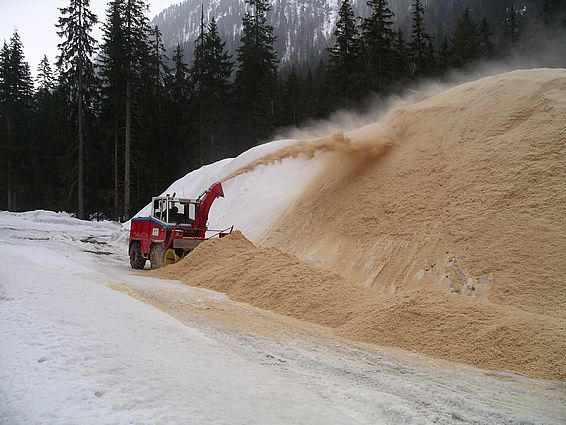23.10.2023 | Jochen Bettzieche | SLF News
In this interview, SLF sports engineer Fabian Wolfsperger explains the effects that warm winters are having on snow farming and why they will delay the start of the upcoming winter sports season and could even scupper it entirely.

Mr Wolfsperger, the winter 2022/23 was warm with little snow. Did the winter sports resorts even manage to fill their snow depots for the start of the coming season?
Not all of them. Things are looking good here in Switzerland. It was touch and go, but it worked out all right in the end. Lenzerheide, Davos and other places have completely replenished their supplies. It's a different matter in Slovenia. Some of the storage facilities there are only half full.
What does that mean for the resorts affected?
In Pokljuka, Slovenia, the depot is only half full. If there were to be more dry weather at the start of the 2023/24 season, they'd have to cancel early-winter international competitions such as the biathlon Junior Cup. If there's no natural snow and it's too warm for artificial snow, they'll be in a tight spot. Half a depot isn't enough for the stadium and the three-kilometre course.
In Jakuszyce, Poland, the situation is even more critical. The resort has a new cross-country skiing centre at an altitude of 900 metres. It started operating in the 2022/23 season, but not for long, as there's only one snow gun there and they had hardly any natural snow. This goes to show that in Europe's central, low mountain ranges, winter sports have no future without snow farming and snowmaking.
Why is there such a big difference in how full the depots are?
Two factors always come into play: the number of cold days and the events calendar. Lenzerheide, for example, had sporting events until the end of January. Snow farming takes place at the exact location where the penalty loops are run in the biathlon, so the resort could only start producing snow for the coming season in February. Fortunately, on a few days it was still cold enough for the snow guns to work.
Can resorts that use snow farming withstand the trend towards ever warmer winters?
That could be difficult in some locations. Notschrei in the Black Forest, at 1,000 metres, has relatively few frost days a year – 63, compared with 116 in Lenzerheide. Last season, all the snow from the depot there had already melted in January. Luckily, it then got cold enough again for them to make snow for next winter. In the next 20 years, however, snow farming offers a lot of potential, especially for Nordic skiing resorts. Four to five kilometres of cross-country ski trail requires comparatively little snow, around 15,000 cubic metres. It's different with alpine skiing. While some Scandinavian resorts in particular are experimenting with snow farming for alpine skiing, this is significantly more energy-intensive and so more expensive, because even small ski slopes require 45,000 cubic metres – three times as much, in other words. We are therefore researching how winter sports resorts can organise their snow management in the future to make the most efficient use of resources.
Contact ¶
Links and documents ¶
Copyright ¶
WSL and SLF provide image and sound material free of charge for use in the context of press contributions in connection with this media release. The transfer of this material to image, sound and/or video databases and the sale of the material by third parties are not permitted.